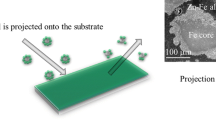Abstract
We suggest electrochemical methods for determining the intensity of local anodic dissolution and hydrogen embrittlement of metals at the tip of a corrosion-fatigue crack. Based on this, we develop a technique for estimating the efficiency of inhibitor protection of structural elements with cracks.
Similar content being viewed by others
References
V. S. Agarwala and J. J. de Luccia, “New inhibitors for crack arrestment in corrosion fatigue of high strength steels,”Corrosion 36, No. 4, 208–213 (1980).
W. T. Tsai, A. Maccari, and D. D. Macdonald, “Effect of silicate and phosphate on fatigue crack growth rates in type 403 stainless steel in concentrated sodium chloride and sodium hydroxide solutions,”Corrosion 39, No. 1, 1–12 (1983).
O. N. Romaniv, G. N. Nikiforchin, and A. T. Tsirul'nik, “Inhibitor protection of high-strength steels against corrosion cracking in the presence of a propagating crack,”Fiz.-Khim. Mekh. Mater. 17, No. 1, 46–53 (1981).
Yu. I. Babei, L. V. Ratych, I. M. Slobodyan, and I. N. Dmytrakh, “The use of inhibitors of complex action for increasing the durability of metal structures in neutral media,”Fiz.-Khim. Mekh. Mater. 21, No. 6, 51–56 (1985).
L. V. Ratych and I. M. Slobodyan, “Influence of inhibitors on the cyclic corrosion cracking resistance of 40Kh steel,”Fiz.-Khim. Mekh. Mater. 23, No. 1, 7–13 (1987).
I. L. Rozenfel'd, V. P. Persiantseva, V. A. Marichev, et al., “Investigation of corrosion inhibitors in water tests,”Zashch. Met. 14, No. 6, 723–726 (1978).
I. L. Rozenfel'd,Corrosion Inhibitors [in Russian], Khimiya, Moscow (1977).
J. S. Robinson,Corrosion Inhibitors. Recent Developments [Russian translation], Metallurgiya, Moscow (1983).
L. I. Antropov, E. M. Makushin, and V. F. Panasenko,Inhibitors of Corrosion in Metals [in Russian], Tekhnika, Kiev (1981).
L. V. Ratych and I. M. Slobodyan, “Influence of inhibitors on the electrochemical conditions in testing 40Kh steel specimens for static corrosion cracking resistance,”Fiz.-Khim. Mekh. Mater. 21, No. 4, 32–37 (1985).
L. V. Ratych and I. M. Slobodyan, “Influence of inhibitors on the electrochemical conditions at a crack tip under cyclic loading of 40Kh steel,”Fiz.-Khim. Mekh. Mater. 22, No. 6, 68–75 (1986).
V. V. Panasyuk, L. V. Ratych, and I. M. Slobodyan, “Evaluation of the efficiency of inhibitor protection of steels against corrosion-mechanical fracture,”Fiz.-Khim. Mekh. Mater. 22, No. 3, 3–15 (1986).
L. V. Ratych and I. M. Slobodyan, “Criteria of inhibitor protection of steels against corrosion-mechanical fracture,”Zashch. Met. 25, No. 5, 723–728 (1989).
V. V. Panasyuk, L. V. Ratych, and I. N. Dmytrakh, “A method for describing the electrochemical conditions at a crack tip in testing structural materials for cracking resistance in corrosive media,”Zavod. Lab. 50, No. 7, 56–59 (1984).
N. P. Zhuk,A Course in Corrosion Theory and Protection of Metals [in Russian], Metallurgiya, Moscow (1976).
H. H. Uhlig,Metal Corrosion [Russian translation], Metallurgiya, Moscow (1968).
Corrosion Fatigue: Chemistry, Mechanics, and Microstructure, NACE, Houston, Texas (1972).
The Influence of Environment on Fatigue, Mechanical Engineering Publishers, London (1977).
Fatigue: Environment and Temperature Effect, Plenum, New York-London (1983).
O. N. Romaniv and G. N. Nikiforchin,Mechanics of the Corrosion Fracture of Structural Alloys [in Russian], Metallurgiya, Moscow (1986).
P. Bristoll and J. A. Roeleveld, “Fatigue of offshore structures and effect of seawater on crack propagation in structural steel,”Proceedings of the European Offshore Steels Res. Seminar, Abington (1980), pp. 314–323.
V. I. Pokhmurskii,Corrosion Fatigue of Metals [in Russian], Metallurgiya, Moscow (1985).
B. F. Brown,The Theory of Stress Corrosion Cracking in Alloys, NATO (1971).
V. V. Panasyuk and L. V. Ratych, “Problems of corrosion fracture mechanics and metal protection,” in:Reliability and Structural Integrity of Advanced Materials, Vol. 1, EMAS, Warley, West Midlands, UK (1992), pp. 451–459.
V. V. Panasyuk, L. V. Ratych, and I. M. Slobodyan, “A method for determining the optimum concentrations of inhibitors,”Inventor's Certificate 1420503 USSR, MKI G01 N 27/46, Published on 30.08.88, Bulletin No. 32.
Additional information
Karpenko Physicomechanical Institute, Ukrainian Academy of Sciences, L'viv. Translated from Fiziko-Khimicheskaya Mekhanika Materialov, Vol. 30, No. 1, pp. 17–25, January–February, 1994.
Rights and permissions
About this article
Cite this article
Panasyuk, V.V., Ratych, L.V. Inhibitor protection of metals at the stage of corrosion-fatigue crack growth. Mater Sci 30, 10–18 (1995). https://doi.org/10.1007/BF00559010
Received:
Issue Date:
DOI: https://doi.org/10.1007/BF00559010




